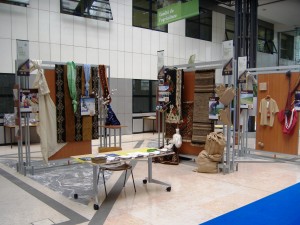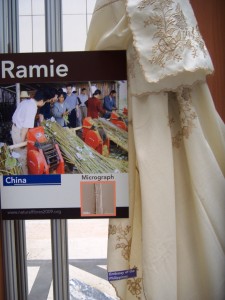- Domesticated sheep spread in two waves.
- How IITA helps yam farmers in West Africa.
- “…it is vital that we develop some sort of early warning system that will enable us to take timely action if we see part of the landscape suffering and signs of the loss of species richness.”
- First issue of newsletter on Agricultural Payments for Ecosystem Services online at Ecoagriculture Partners.
- Visit Cairo’s Agricultural Museum. If you think you can take it.
In praise of Granny Smith
Our regular readers 1 will know that there’s been a regular deluge — windfall? — of apple stories in the past few months, in particular about the imminent demise of the British orchard. The latest surfaced today. In such stories, aspersions are often cast on the qualities of such commercial favourites as the Granny Smith. 2 I guess the unspoken implication is that this and similarly successful varieties are the evil spawn of some sinister multinational, and probably contain, to boot, genes cruelly extracted from some Arctic fish without its prior or informed consent and unnaturally inserted into the pristine apple genome by soulless pointy-headed boffins with Nazi sympathies.
Nothing could be further from the truth, it turns out, at least in the case of the Granny Smith, which was, in fact, spotted as a seedling and first grown by Maria Ann Smith on her farm in Ryde, New South Wales around 1868. 3 It started life as the kind of backyard variety that would later become known as a heirloom. So, I ask myself, what obscure pome, currently languishing in some forgotten British orchard, soon to be rescued by the imminent influx of National Trust money, will eventually knock old Granny from her pedestal? And when will we be complaining about that one?
Ramie ruminations
Not a day passes that I don’t utter an imprecation — as Julian Simon Barnes did in print a few days back — at agrobiodiversity. Take yesterday. There’s a big meeting going on this week at FAO, and they’ve set up a series of stands in the atrium. Most of them are pretty boring, just piles of publications and the odd poster, but the one put up by the people behind the International Year of Natural Fibres is very nice indeed.

It has examples of handicrafts and other products made from a whole lot of different fibres, from abaca to muskox. Including ramie. And that’s when I cursed the neverending-ness of biodiversity. For what, pray, is ramie? I know abaca and muskox, but I’d never heard of ramie.

Well, it turns out to be Boehmeria nivea, a shrub in the nettle family widely cultivated in East Asia since antiquity for its bark, which is used to make fabrics. The IYNF website has a page about it. The Korean national costume (the hanbok) is made of ramie cloth, so we’re not talking about a minor, obscure, criminally underused plant here. Bloody agrobiodiversity indeed. I hate you.
Nibbles: Japan, Bananas, GMO, Bees, Squirrels, Mangroves, Climate change and indigenous people, Goji, Svalbard, Heirloom rice, Dataporn
- Japan’s unemployed end up farming.
- Somewhat uninformed comments about the perfection of the banana.
- “…traditional genetic crosses outperform genetically modified crops by a wide margin.”
- Alice Waters takedown.
- Brits throw money at bees.
- Red squirrel missing link found through DNA fingerprinting. Red squirrel pie, anyone? Ok ok, make it grey.
- Mexican mangroves in trouble.
- “Indigenous Peoples have contributed the least to the global problem of climate change but will almost certainly bear the greatest brunt of its impact.”
- Go go goji.
- Secretary General of the Nordic Council of Ministers and former Icelandic Prime Minister waxes lyrical about genebanks.
- So there’s a Carolina Gold Rice Foundation. No, not Golden Rice. Via.
- Help the Biodiversity Heritage Library decide on a citation format. Or not. whatever.
Where are the peanuts?
Another splendid Moche tomb has come to light: the finery buried with the Lord of Ucupe is said to be even more impressive than that of the Lord of Sipan. According to the archaeologists, “it’s unheard of to find so many precious funerary ornaments in a single Moche tomb.” Alas, no sign of the wonderful gold and silver necklace and earrings in the shape of peanuts (groundnuts) which graced the mummy of the Lord of Sipan.
I talked about this with our resident peanut expert David Williams and he said he expected that the excavators will have “found some jars full of actual peanuts as part of the all the stuff included in the burial; it’s very common in Moche tombs.” There is a theory, he explained, that peanuts were associated with death, the journey to the afterworld and reincarnation.
When planted, the peanut grows and flowers above ground like any other plant, but then it buries its fruit underground, where it germinates, returning back into the “world of the living”, growing and flowering and burying its fruit, and so on and on, for generations (or incarnations). Plus, the peanut shell is like a little coffin. Peanuts, because of their high protein and caloric value, as well as their lightweight, durable “packaging”, make great travel food, particularly for the long journey to the afterlife.